Keyword research is a critical component of your overall marketing strategy and, more specifically, your business’ on-page SEO strategy. Keywords represent words, phrases, and numbers that might be searched by a person online. They’re related to queries asked by users in search engines. Keyword research is done to find the highly used keywords that your target audience enters into search engines.
If you aren’t using the best keywords for your target audience, you can’t maximize your SEO results. To best know your audience, your competition, and your market, you can’t guess — you need to do research. We’ve got you covered in this complete keyword research guide.
In this guide, you’ll learn:
Keyword research helps you determine which words or phrases are best to target for your marketing efforts. It provides valuable information about the search queries your target audience is searching for – it informs your strategy – and ensures that you show up on the search engine results pages for your audience. 94.7% of keywords get ten monthly searches or fewer. So it’s important to choose the right words for your content/page.(source)
First things first, it’s important to distinguish the different types of keywords:
There are different types of search intent that you’ll come across, including:
It starts with brainstorming keywords you can use in developing your strategy. Instead of searching randomly, we use different tools to determine these searches.
SERP Analysis
To start the research – let’s say you’re looking for keyword ideas for email marketing solution – type your main topic in Google Search and check the results. Most of the top results for “email marketing platform” have used keywords like email marketing software, email marketing tool, free email marketing tool, and more. This will give an idea of the keywords the top-ranking pages are optimized towards (example below).
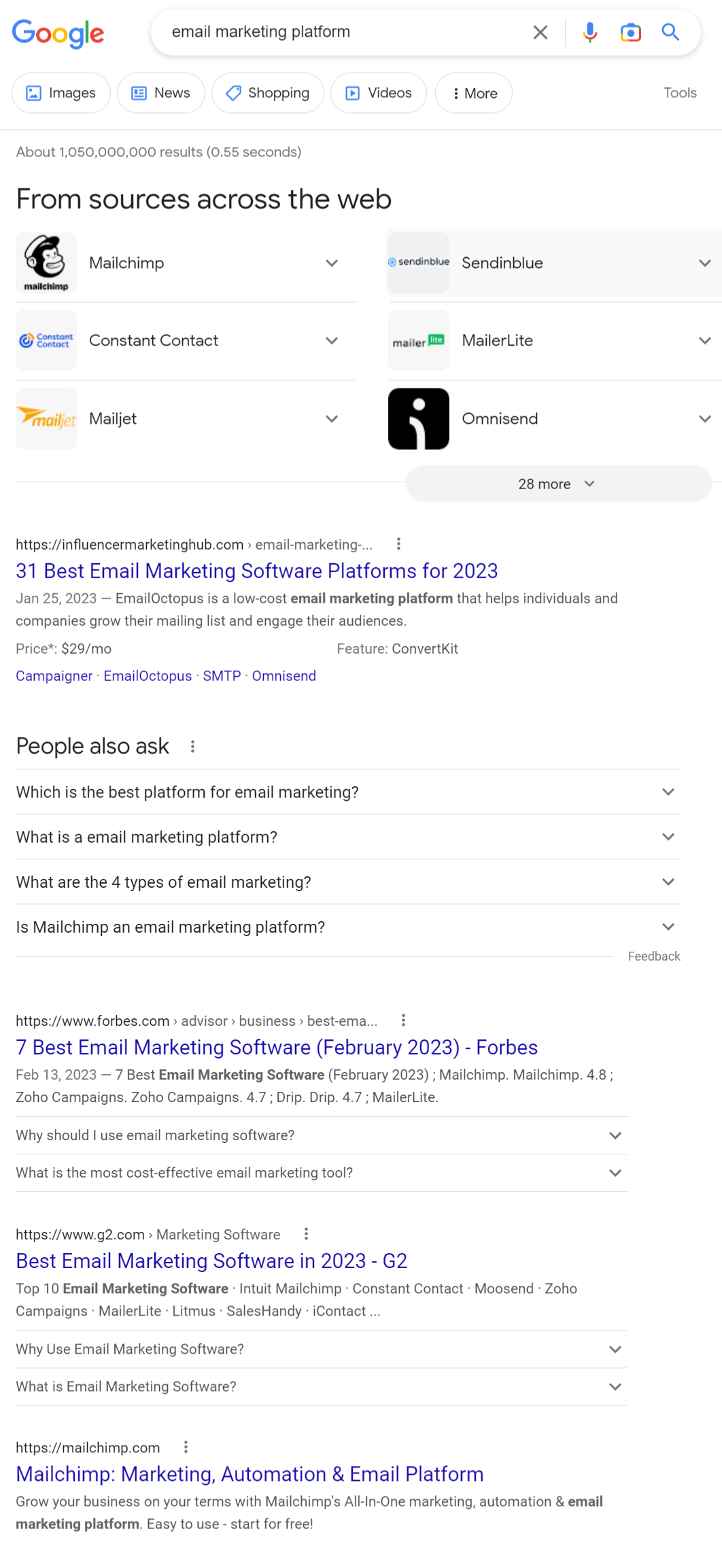
Google-related Searches
Next, scroll to the bottom of the search page to find more keywords in “Related Searches.”
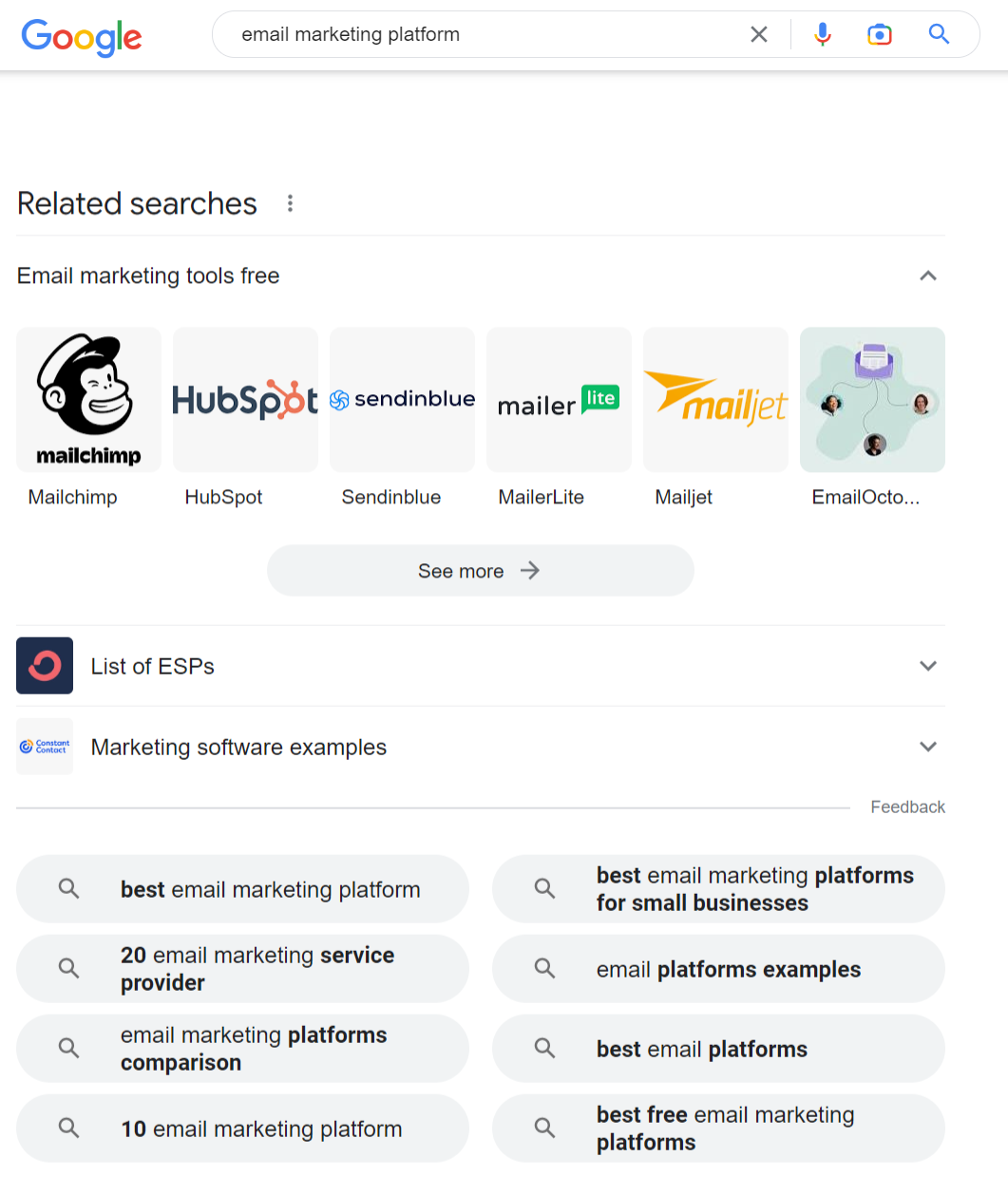
These are keywords that are considered related to your main topic by Google – click any keyword from this list and analyze the People Also Ask and Related Searches sections.
Repeat as often as necessary for additional keyword ideas.
Google Search Autocomplete
When typing a keyword in Google Search, it shares suggestions based on the most frequently searched and relevant topics. If you’re looking for even more ideas, add words like for, in, on, etc., to find different angles.
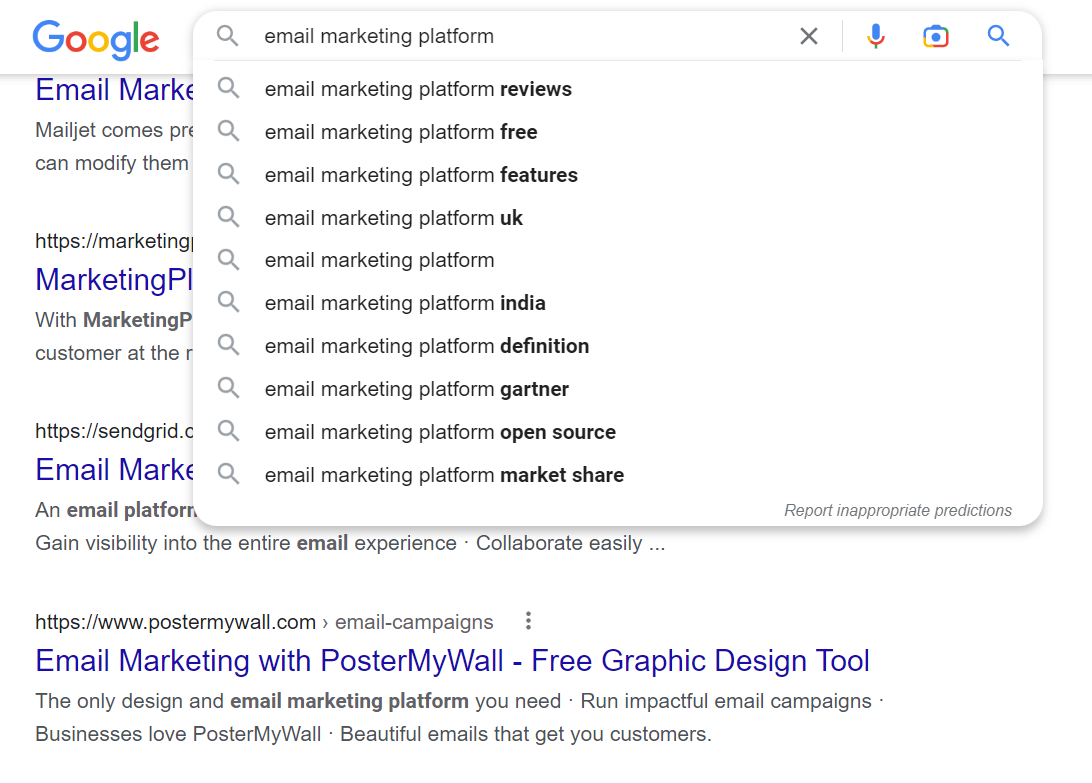
Keyword Planner is Google’s free research tool that can also be used to generate ideas.
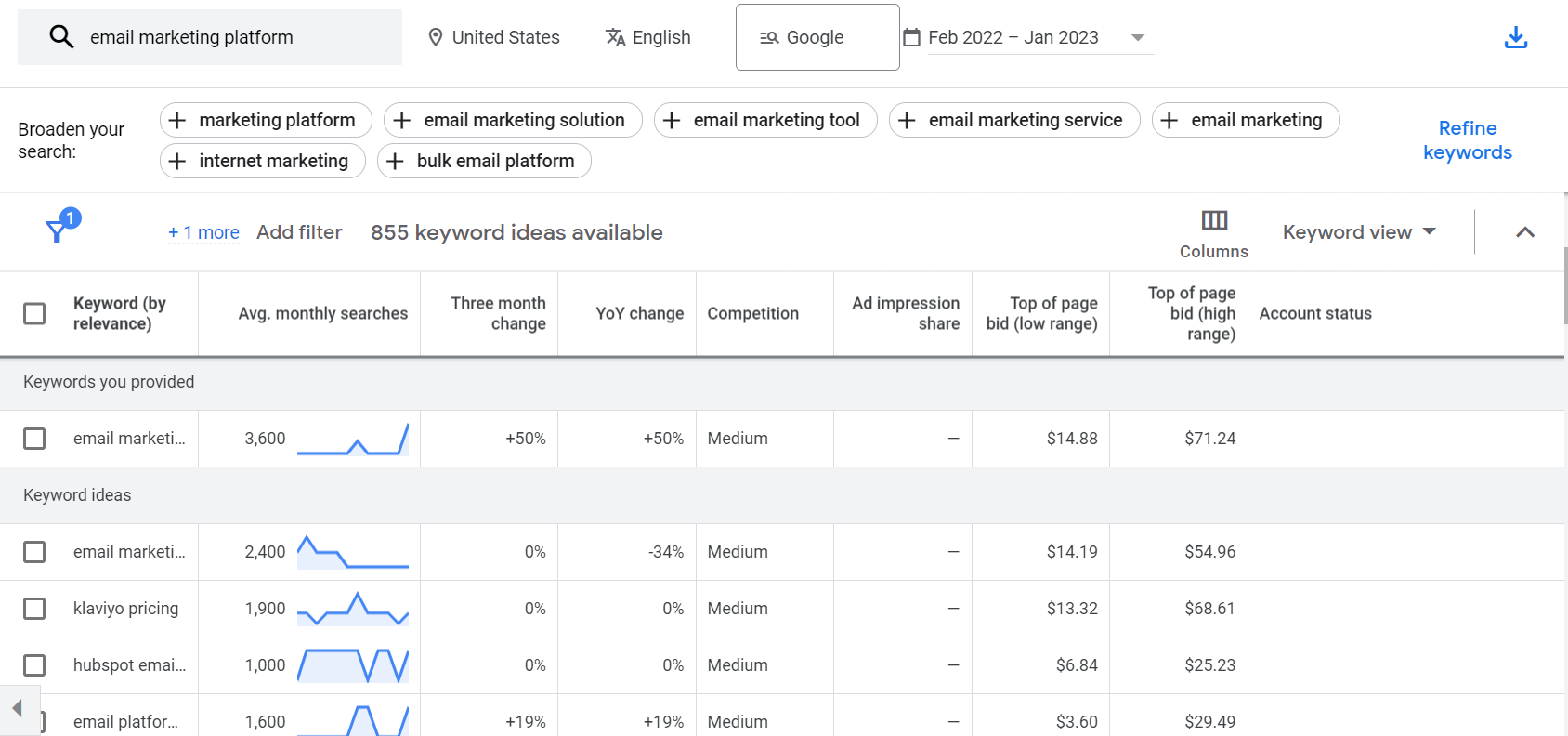
How to use the planner:
The keywords found through Google Planner are closely related to your parent keyword and can help you determine additional words and phrases to target in your strategy.
Reddit And Other Forums
Besides Google Search, discussion forums like Reddit, Quora, LinkedIn Groups, etc., are also good sources of new keywords you haven’t considered – you’ll access real discussions with people and their issues (and questions).
Researching competitor keywords are a great way to find good opportunities.
To do a competitor analysis, we recommend these top research tools:
You’ve identified some solid keyword options, now it’s time to determine which keywords are worth targeting.
Search Volume
Search volume is the approximate number of times people search for a keyword in Google. Ideally, you want to target high-search volume keywords for your business, the caveat is that high-volume keywords can be costly – we recommend targeting low-mid traffic range / long-tail keywords.
Pay Attention to “Zero Search Volume” Keywords
When you’re utilizing a research tool, you may find relevant long-tail keywords with zero search volume, don’t let these numbers fool you.
If this keyword is super relevant to your audience’s needs, a question customers regularly ask you, or a topic that covers an important point about your product – don’t ignore it just because a tool is telling you it gets little to no traffic – it can still drive relevant traffic to your site.
Search volume doesn’t tell the entire story – you’ve got to analyze a keyword’s ranking difficulty and competition to see if it’s worth targeting.
Keyword competition measures how much work is needed to get in a keyword’s top ten search results. Many of the research tools offer Keyword Difficulty Score.
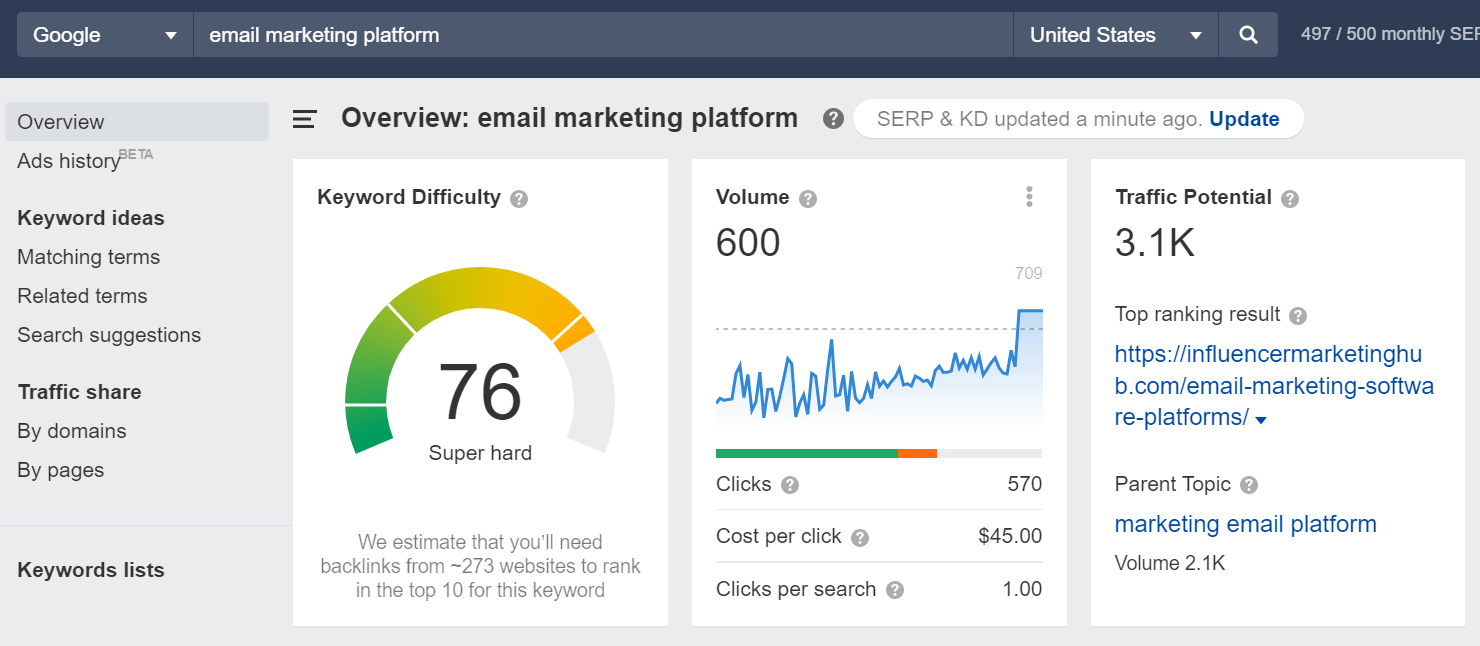
The ranking is out of 100 – the higher the keyword difficulty score is – the harder it is to rank in the top results.
Organic search CTR is the percentage of users who click a keyword’s search results. This is important because according to a study, nearly 65% of all organic searches generate zero clicks. (Source)
One of the reasons this is happening is because Google is increasingly answering user queries within its search pages, meaning the user doesn’t even have to click on a search result to get their answer.
That being said, you don’t want to be ranking for a keyword with a low search CTR.
When evaluating keywords, make sure they have:
Using one of the tools we listed above will help you with search volume, competition, etc.
Search intent is important to consider when evaluating keywords – it’s the reasoning behind why a user searches for a particular keyword.
Earlier, we talked about the types of search intent, they were: Navigational, Informational, Commercial and Transactional
If your page is aligned with the search intent of a keyword, Google will rank it. Otherwise, you’ll be nowhere in the SERPS even with the most perfectly optimized content.
Based on the search internet of your keywords, you need to organize and prioritize them for content production.
We recommend that you use your B2B content marketing funnel, which has three stages.
Top of the funnel content drives the most traffic to your site because it targets high search volume informational keywords. However, this traffic rarely drives sales alone.
It’s more critical to prioritize middle and bottom-funnel content, which covers commercial and transactional keywords.
This approach has two benefits:
The key factors to consider when deciding which keywords to focus your SEO efforts on.
1. High Search Volume
Ensure you’re choosing keywords that are highly relevant and being actively searched for. Using tools and researching will help you determine this and the keywords that can bring the most visitors to your website.
2. Relevance
It’s important to choose accurate keywords that realistically reflect what product or service you offer.
3. Strong Conversion Value
It’s important to choose words that will attract an audience ready to make a purchase or, at the very least, visit your page.
4. Reasonable
It’s important to focus on realistic keywords that you can try to rank with. Some are so overused that you might not have a chance to rank, make sure you consider this.
5. Specific
Make sure your keywords are specific to what your business has to offer for products or services.
6. Audience-Focused
Think about your audience. What do they want? What do they need? Target your keywords around this and what your audience is looking for.
7. Competitive
Study your competition and identify what keywords they’re targeting. Paying attention to your competitors helps you with your own target keyword list and broadening it.
8. Be Agile
Don’t stop assessing your keywords and what’s working once they go live. Using keyword research and analytic tools will help you identify which keywords are effective and which need to be switched out.
Implementing this approach will help you identify the right keywords for your business – you’ll be on your way to a solid SEO plan. Don’t forget to re-evaluate your keywords every few months. As you gain more authority in the SERPs, you can add more keywords to your list to help you grow in new areas.
Having a good keyword strategy – grounded in keyword research – can make an impact on your marketing efforts and your ovrall business, driving customers in organically. If you’re looking for an SEO partner with years of experience bringing keyword research and SEO performance to life, look no further than Position2.